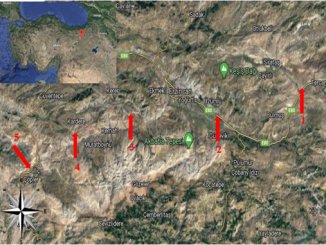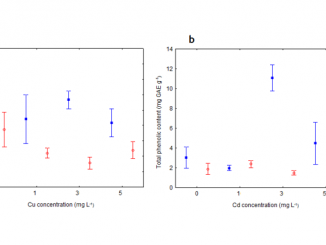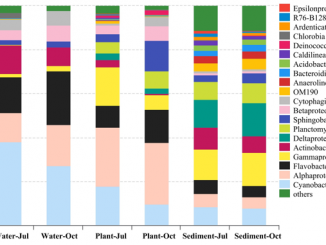
Paper category: Original research paper
Corresponding author: Amaal M Abdel-Satar (abdelsatarmena11@yahoo.com)
DOI: 10.1515/ohs-2020-0001
Received: 17/06/2019
Accepted: 28/08/2019
Full text: here
Citation (APA style): Al-Afify, A. & Abdel-Satar, A. (2020). Risk assessment of heavy metal pollution in water, sediment and plants in the Nile River in the Cairo region, Egypt. Oceanological and Hydrobiological Studies, 49(1), pp. 1-12. Retrieved 11 Mar. 2020, from doi:10.1515/ohs-2020-0001
Abstract
Samples of water, sediment and two native plants (Eichhornia crassipes and Ceratophyllum demersum), collected seasonally from eight sites, were analyzed to investigate the level of contamination with metals (Fe, Mn, Ni, Co, Zn, Cu, Cr, Pb and Cd) in the Nile River in the Cairo region, using heavy metal pollution and contamination indices in the case of water, and the geoaccumulation index, the pollution load index, the enrichment factor and the potential ecological risk factor in the case of sediment. The results clarified that the levels of metals among three compartments were in order: sediments > plants > water. The Nile water in Cairo is not critically polluted by the studied metals and the metal pollution index for most sites does not exceed the critical limit (< 100). Sediment samples showed a clear accumulation of Mn, Ni and Cd when compared with benchmarks cited by the Environmental Protection Agency (EPA), especially during low flow seasons. The contribution of Cd to the ecological risk assessment was about 80%, while the contribution of Ni was about 10%, reflecting that these elements originated primarily from anthropogenic sources. Eichhornia crassipes and Ceratophyllum demersum have a higher accumulation capacity for Mn, Cu and Fe compared to the other studied metals.
References
Abdel-Satar, A.M., Ali, M.H.H & Goher, M.E. (2017). Indices of water quality and metal pollution of Nile River, Egypt. Egypt. J. Aqua. Res. 43: 21–29.
Al-Afify, A.D.G., Othman, A.A. & Ramadan, M.A. (2018). Characterization of chemical and microbiological quality of Nile River surface water at Cairo (Egypt). Rend. Fis. Acc. Lincei. 29: 725–736.
Alahabadi, A. & Malvandi, H. (2018). Contamination and ecological risk assessment of heavy metals and metalloids in surface sediments of the Tajan River, Iran. Mar. Pollut. Bull. 133: 741–749.
Ali, M.M., Ali, M.L., Islam, M.S. & Rahman, M.Z. (2016). Preliminary assessment of heavy metals in water and sediment of Karnaphuli River, Bangladesh. Environ. Nano., Monit. & Manage. 5: 27–35.
APHA (American Public Health Association). (2005). American Water Works Association. Standard methods for the examination of water and wastewater. New York.
APRP (Agricultural Policy Reform Program). (2002). Water Policy Program, Survey of Nile System Pollution Sources. Report No. 64.
Backman, B., Bodis, D., Lahermo, P. & Rapant S. (1997). Application of a groundwater contamination index in Finland and Slovakia. Environ. Geol. 36(1–2): 55–64.
Banerjee, A.D.K. (2003). Heavy metal levels and solid phase speciation in street dusts of Delhi, India. Environ. Pollut. 123: 95–105.
CCME (Canadian Council of Ministers of the Environment). (2007). For the protection of aquatic life 2007. In: Canadian Environmental Quality Guidelines, 1999, Canadian Council of Ministers of the Environment, 1999, Winnipeg.
CCME (Canadian Council of Ministers of the Environment). (2014). Canadian Water Quality Guidelines: Cadmium. Scientific Criteria Document. Canadian Council of Ministers of the Environment, Winnipeg. ISBN 978-1-77202-000-7 PDF.
Chen, H., Teng, Y., Lu, S., Wang, Y. & Wang, J. (2015). Contamination features and health risk of soil heavy metals in China. Sci. Total Environ. 512: 143–153.
Coci, M., Nicol, G.W, Pilloni, G.N., Schmid, M., Kamst-van Agterveld M.P. et al. (2010). Quantitative assessment of ammonia-oxidizing bacterial communities in the epiphyton of submerged macrophytes in Shallow Lakes. Appl. Environ. Microbiol. 76: 1813–1821.
Duncan, A.E., de Vries, N. & Nyarko, K.B. (2018). Assessment of Heavy Metal Pollution in the Sediments of the River Pra and Its Tributaries. Water Air Soil Pollut. 229(8): 272.
Effendi, H., Kawaroe, M., Mursalin & Lestari, D.F. (2016). Ecological risk assessment of heavy metal pollution in surface sediment of Mahakam Delta, East Kalimantan. Proc. Environ. Sci. 33: 574–582.
EPA (Environmental Protection Agency). (2006). Region III BTAG Freshwater Sediment Screening Benchmarks 8/2006.
EWQS (Egyptian drinking water quality standards). (2007). Ministry of Health, Population Decision number 458.
Hakanson, L. (1980). An ecological risk index for aquatic pollution control. A sedimentological approach. Water Res. 14: 975–1001.
Hakanson, L. (1988). Metal monitoring in coastal environments, In U. Seeliger, L.D. Lacerda & S.R. Patchineelam (Eds.), Metals in Coastal Environments of Latin America (pp. 240–257). Springer Verlag.
Islam, M.S., Ahmed, M.K., Habibullah-Al-Mamun, M. & Hoque, M.F. (2015). Preliminary assessment of heavy metal contamination in surface sediments from a river in Bangladesh. Environ. Earth Sci. 73: 1837–1848.
Jensen, S.I., Kuhl, M. & Prieme, A. (2007). Different bacterial communities associated with the roots and bulk sediment of the seagrass Zostera marina. FEMS. Microbiol. Ecol. 62: 108–117.
Kastratović, V., Krivokapić, S. Bigović, M., Đurović, D. & Blagojević, N. (2014), Bioaccumulation and translocation of heavy metals by Ceratophyllum demersum from the Skadar Lake, Montenegro, J. Serb. Chem. Soc. 79(11): 1445–1460.
Kouadia, L. & Trefry, J.H. (1987). Saline trace metal contamination in the Ivory. Air Water Soil Pollut. 32: 145–154.
Miretzky, P., Saralegui, A. & Cirelli, A.F. (2004). Aquatic macrophytes potential for the simultaneous removal of heavy metals (Buenos Aires, Argentina). Chemosphere 57(8): 997–1005.
Mohan, S.V., Nithila, P. & Reddy, S.J. (1996). Estimation of heavy metal in drinking water and development of heavy metal pollution index. J. Environ. Sci. Health A 31(2): 283–289.
Mohiuddin, K.M., Otomo, K., Ogawa, Y. & Shikazono, N. (2012). Seasonal and spatial distribution of trace elements in the water and sediments of the Tsurumi River in Japan. Environ. Monit. Assess. 184: 265–279.
Müller, G. (1969). Index of geo-accumulation in sediments of the Rhine River. Geol. J. 2: 109–118.
Narain, S., Ojha, C.S.P., Mishra, S.K., Chaube, U.C. & Sharma, P.K. (2011). Cadmium and chromium removal by aquatic plant. Int. J. Environ. Sci. 1: 1297–1304.
Pajević, S., Borišev, M., Rončević, S., Vukov, D. & Igić, R. (2008). Heavy metal accumulation of Danube River aquatic plants – indication of chemical contamination. Cent. Eur. J. Biol. 3(3): 285–294.
Pajević, S., Vučković, M., Stanković, Ž., Krstić, B., Kevrešan, Ž. et al. (2002). The content of some macronutrients and heavy metals in aquatic macrophytes of three ecosystems connected to the Danube in Yugoslavia. Archiv für Hydrobiologie, Large Rivers 13: 73–83.
Prasad, B. & Bose, J.M. (2001). Evaluation of heavy metal pollution index for surface and spring water near a limestone mining area of the lower Himalayas. Environ. Geol. 41: 183–188.
Prasad, B. & Mondal, K.K. (2008). The impact of filling an abandoned opencast mine with fly ash on ground water quality: a case study. Mine Water Environ. 27(1): 40–45.
Prasad, M.N.V. & Freitas, H.M. (2003). Metal hyperaccumulation in plants – Biodiversity prospecting for phytoremediation technology. Electro. J. Biotechnol. 6(3): 286–290.
Rybak, A., Messyasz, B., & Łęska, B. (2013). The accumulation of metal (Co, Cr, Cu, Mn and Zn) in freshwater Ulva (Chlorophyta) and its habitat. Ecotoxicology 22(3): 558–573.
Saison, C., Schwartz, C. & Morel, J.L. (2004). Hyperaccumulation of metals by Thlaspi caerulescens as affected by root development and Cd-Zn/Ca-Mg ineraction. Intl. J. phytoremediation 6(1): 49–61.
Shaltout, K.H., Gala, T.M. & El-Komi, T.M. (2009). Evaluation of the Nutrient Status of Some Hydrophytes in the Water Courses of Nile Delta. Egypt. J. Bot. 2009: 1–12.
Singh, H., Pandey, R., Singh, S.K. & Shukla, D.N. (2017). Assessment of heavy metal contamination in the sediment of the River Ghaghara, a major tributary of the River Ganga in Northern India. Appl. Water Sci. 7: 4133–4149.
Thevenon, F., Graham, N.D., Chiaradia, M., Arpagaus, P., Wildi, W. et al. (2011). Local to regional scale industrial heavy metal pollution recorded in sediments of large freshwater lakes in central Europe lakes Geneva and Lucerne over the last centuries. Sci. Total Environ. 412: 239–247.
Vardanyan, L.G. & Ingole B.S. (2006). Studies on heavy metal accumulation in aquatic macrophytes from Sevan (Armenia) and Carambolim (India) lake systems. Environ. Int. 32: 208–218.
Wahaab, R.A. & Badawy, M.I. (2004). Water Quality Assessment of the River Nile System: An Overview. Biomed. Environ. Sci. 17: 87–100.
WHO (World Health Organization). (2011). Guidelines for drinking-water quality, fourth ed. Geneva: WHO, 564p. ISBN: 978 92 4 154815 1.
Yahaya, M.I., Jacob, A.G., Agbendeh, Z.M., Akpan, G.P. & Kwasara, A.A. (2012). Seasonal potential toxic metals contents of Yauri river bottom sediments: North western Nigeria. J. Environ. Chem. Ecotoxicol. 4(12): 212–221.




Be the first to comment